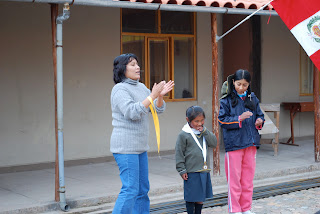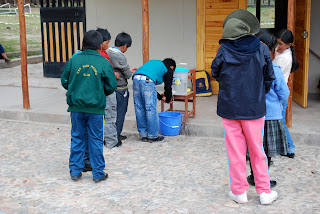March 12, 2012
Today, Jesse and I visited the school sponsored by Mitchell & Co at Mallkini. The school hosts 22 girls and 19 boys ranging in age from 5 to 12. And, the children stay at the school from Monday to Friday before returning home to help their parents. Each day, the children are fed 3 nutritious meals, which helps to fight malnutrition. We joined the children for breakfast as they arrived to school for the first day of the week. We also had the opportunity to eat lunch at the school. It was the second time we ate alpaca!
The 41 children are divded by grade. There are three teachers who each teach two grades. First and second grade is in on classroom, third and fourth in another, and finally fifth and sixth in the last. Today was the first official day of the school year and one of the girls we met herding alpacas yesterday received an award for the highest grade from her class last year! The children were all very well behaved and participate in cleaning the dining room after eat meal.
After breakfast, Jesse and I acted as artists in the first and second grades, drawing horses, alpacas, cows, dogs and cats for the children! They were very exited to have us in te classroom. We also sat in on the other two classrooms as they started their studies.
After we ate lunch at the school, we returned to the Mallkini house and ate a second lunch... We were beyond full but everything is always delicious. We are very fortunate to have the opportunity to try so many Peruvian dishes, dessert included!
In the evening we met with the Mallkini staff to learn more about alpacas. There are two types: huacayo and suri and on average, fully grown alpacas weigh 140 lbs. We also talked about the economics of alpaca farming in Peru. Mallkini has 4,000 alpacas and the largest alpaca farm in the country has 60,000 alpacas! But, 80 percent of all pervian alpacas can be found on small farms, 100 alpacas or less. Small farms do not earn much profit from alpaca farming, often only enough to survive. In general, the alpaca fiber price is set my the demand in the international markets (particularly European fasion houses and their demand for the product).
Tomorrow, we will dive into the first step of exporting fiber: shearing. I am very excited to see the process!
-Leah
Mallkini (view from our room)
Awards at School
The students washing their hands before class
Girls dorm
First Graders
First Graders
Lunch at school (alpaca!)
Dessert at Mallkini (lunch)
Dessert at Mallkini (dinner)









No comments:
Post a Comment